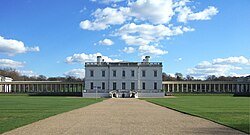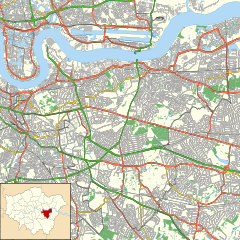
Back Queen's House Afrikaans بيت الملكة Arabic Квінс-хаус Byelorussian Queen's House Danish Queen’s House German Queen’s House Esperanto Casa de la Reina (Greenwich) Spanish Queen's House Basque خانه ملکه Persian Queen’s House Finnish
| Queen's House | |
|---|---|
 The Queen's House, viewed from the main gate | |
| General information | |
| Location | Greenwich London, SE10 United Kingdom |
| Construction started | 1616 |
| Completed | 1635 |
| Client | Anne of Denmark |
| Owner | Royal Museums Greenwich |
| Design and construction | |
| Architect(s) | Inigo Jones |
| Designations | Grade I listed Scheduled monument |
| Website | |
| Queen's House | |
Queen's House is a former royal residence in the London borough of Greenwich, which presently serves as a public art gallery. It was built between 1616 and 1635 on the grounds of the now demolished Greenwich Palace, a few miles downriver from the City of London. In its current setting, it forms a central focus of the Old Royal Naval College with a grand vista leading to the River Thames, a World Heritage Site called, Maritime Greenwich. The Queen's House architect, Inigo Jones, was commissioned by Queen Anne of Denmark in 1616 and again to finish the house in 1635 by Queen Henrietta Maria. The House was commissioned by both Anne and Henrietta as a retreat and place to display and enjoy the artworks they had accumulated and commissioned; this includes a ceiling of the Great Hall that features a work by Orazio Gentileschi titled Allegory of Peace and the Arts.
Queen's House is one of the most important buildings in British architectural history, due to it being the first consciously classical building to have been constructed in the country. It was Jones's first major commission after returning from his 1613–1615 grand tour[1] of Roman, Renaissance, and Palladian architecture in Italy. Some earlier English buildings, such as Longleat and Burghley House, had made borrowings from the classical style, but the structure of these buildings was not informed by an understanding of classical precedents. Queen's House would have appeared revolutionary during this period. Although it diverges from the mathematical constraints of Palladio, Jones is often credited with the introduction of Palladianism with the construction of the Queen's House. Jones' unique architecture of the Queen's House also includes features like the Tulip Stairs, an intricate wrought iron staircase that holds itself up, and the Great Hall, a perfect cube.
After its brief use as a home for Royalty, the Queen's House was incorporated into use for the complex for the expanding Royal Hospital for Seamen. Neoclassical colonnades wings and buildings were added in the early nineteenth century for a Seaman's school. Today the building is both a Grade I listed building and a scheduled monument; A status that includes the 115-foot-wide (35 m) axial vista to the River Thames. The house is now serves as part of the National Maritime Museum and is used to display parts of its substantial collection of maritime paintings and portraits.
- ^ The phrase 'Grand Tour' was unknown until approximately 1670, but in essence, Jones's tour of Germany, Italy and France, incorporated many of the elements of the later tour.
